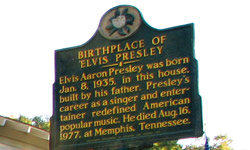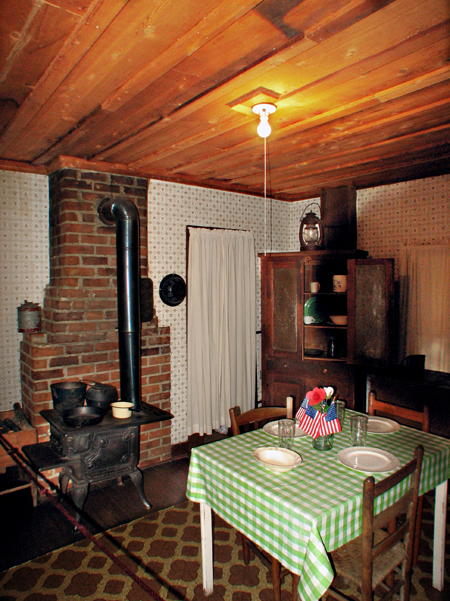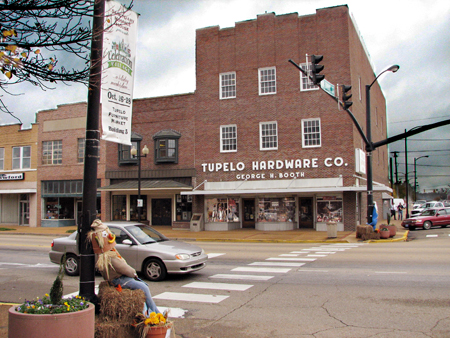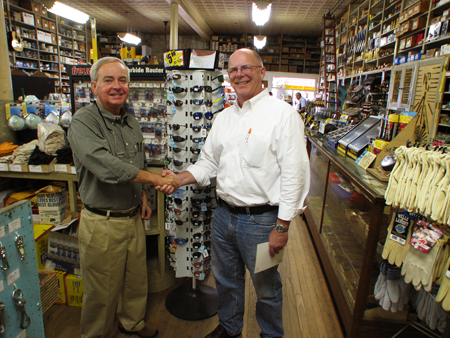Visiting Elvis' small-town roots
If you're like me, some day will find you flying over the Deep South, looking for a fuel stop that can offer a bit more than fuel. In my case, a line of thunderstorms over my flight-planned destination prompted the decision to divert to the Tupelo Regional Airport in Tupelo, Mississippi. The airport has a part-time tower, plus an ILS, VOR/DME, GPS RNAV, and even an NDB approach — all of which were welcome enticements in a rapidly deteriorating weather situation. The single runway, 18/36, is 6,500 feet long and 100 feet wide, with pilot-controlled lighting. Plenty long enough for virtually all general aviation airplanes. In fact, Delta and Northwest both serve Tupelo — in case you really get stranded.
It was after AOPA Pilot Senior Editor Al Marsh and I landed, however, that Tupelo's real attractions began asserting themselves. After taxiing up to the Tupelo Aero ramp (Southernaire is the other FBO) we gassed up and chatted with the amiable front-desk staff. We were hungry, and asked about nearby restaurants.
Of course, I already knew that Tupelo was Elvis Presley's birthplace, and where he spent the first 13 years of his life before his family set out for a better life in Memphis. But I was not prepared for Tupelo's somewhat elaborate Elvis industry. I say "somewhat elaborate" because there's a down-home, Mayberry-like atmosphere to the place that radiates as much humility and Southern charm as it does pride in its prodigal son.
A 1992 Lincoln Town Car
Tupelo Aero keeps a rapidly aging Town Car as its crew loaner. We took the generous offer to let us use this land yacht — free — for a full 24 hours, since no one else was expected to arrive in such crummy weather. And off we went, in search of Elvis' roots. A Tupelo Aero map of Tupelo — complete with stops for the "Elvis Driving Tour" — led the way.
Marsh, as is his custom, was prepared for the adventure. He had his huge digital camera, and all the software he needed for tweaking his photos, making movies, and burning DVDs on his laptop. The images and movies accompanying this article are his handiwork.
Marsh may be a good pilot and photographer, but the Town Car tested his nerves. There was no rearview mirror (but you could see where glue once held it, right next to that chip in the windshield). He managed to lock us out of the trunk one time. The driver's door wouldn't shut all the way. Only one electric window worked. The car's tie rods were shot, so the front end wandered a bit, requiring constant corrections if a straight path was to be maintained. And when Marsh hit the master switch for the door locks, the switch assembly fell out and dropped deep into the door's innards. It was a car with personality. You had to love it.
 Click the image above to view a slideshow.
Click the image above to view a slideshow.











The shotgun house
We pointed the Town Car down Jackson Street, weaved through the small downtown area, went up East Main Street, and then hung a left at Elvis Presley Drive. That's where the Elvis Presley birthplace and museum complex is located. Admission is $2.50 for adults, $1.50 for kids. For $7 and $3.50, respectively, you can see both the house and the museum — parts of which were under construction at the time of our visit (October 31, 2006).
Elvis' birthplace catches your eye first. This is a two-room "shotgun" house with a floor plan no larger than a couple of hundred square feet or so. The bathroom was an outhouse. The Presleys were "knee-showing" poor (meaning their pants were worn through at the knees), said a weary docent who explained all the details surrounding the house: that Vernon, Elvis' dad, built the house with a $180 loan in 1934 (the hammer he used is on display in the museum); that Vernon went broke, defaulted on the loan, and lost the house three years later; and that Elvis and his stillborn twin, Jesse, were born in a corner of the front room on January 8, 1935.
The furniture in the house is not the furniture from the mid-1930s. Curators have done their best, however, to seek out items contemporary to the day — a wood stove, a lamp, a bed (the family shared a single bed) — which might well have been owned by the poverty-stricken Presleys. Similarly, the house's structure is not exactly true to life. The ceiling and roof have been replaced, but the rest of the house is original. So is the house's location. After Elvis hit it big, he bought the original house and began the effort to establish the museum.
You can't look at that house and not come to terms with what a rags-to-riches story began there. A gift shop adjoins the birthplace, where you can buy all manner of Elvis memorabilia — both kitschy (clocks, snow globes) and classic (recordings of Elvis' first appearances on television). There's also a replica of the 1937 Plymouth that Vernon drove when the family left Tupelo, statues, and a chapel where Elvis' tunes prevail. A Web site gives more details. Some gift shop items can be bought online.
Tupelo Hardware
The tour map also mentions the hardware store where Elvis' mother, Gladys, bought him his first guitar in 1945. Now, like then, the building is a nondescript two-story brick structure. It's a real, old-fashioned hardware store, with wood floors, layers of shelves stacked high and full of stock, and old wooden boxes full of nuts, bolts, and other paraphernalia. It antedates big-box atrocities like Home Depot by decades, and it was refreshing to behold. We parked the Town Car out front and went inside.
The door swung open, and we were quite alone in the store. A salesman approached, asked us what we wanted, and we asked about Elvis' guitar purchase. "Oh, you want the guide," he said.
Howard Hite stepped forward. A relative of the owner at the time of The Purchase, Hite went into an entire spiel about the store, and its place in history. We were an audience of two, but Hite had his material down pat. He went through a 15-minute monologue, complete with props — and a mark on the floor where a young Elvis stood, waiting to receive the implement of his fame.
Seems Gladys took the 10-year-old Elvis to the hardware store to buy whatever he wanted. The King's first choice was a .22-caliber rifle. Too dangerous, said Mom. A bicycle was second choice, also vetoed as dangerous. The guitar was the consolation prize for the now-sulking Elvis, goes the legend. But the rest was history.
Hite said he gets about 20,000 tourists a year, which we found unbelievable. But later, when we drove by, two huge tour buses had disgorged their cargo, which was patiently waiting in a long line. "Many of the visitors are from England," Hite said. "But we've had other people — stars — come by. Like Aerosmith. They want to buy a guitar, and we still sell them."
Johnnie's Drive-In
Hite suggested Johnnie's Drive-In as the next stop on the Elvis tour. Elvis used to hang out there as a kid, developing his taste for greasy burgers and fries. Johnny's is pretty much the same as it was back then, complete with a grease-saturated atmosphere ("the ventilation isn't so good," Hite said) and a booth dubbed "the Elvis booth." This is a booth that Elvis frequented, as identified in a photograph mounted on the wall.
An old-timer at Johnnie's remembered Elvis from the early days, and some of the waitresses could well have made the same claim. One had worked there for 30 years.
A Johnnie's specialty is the "dough-burger," so called because its recipe calls for mixing flour in with the ground beef. That's how you stretched out your beef supply in the rural South of the 1930s and 1940s.
Schools, and the fairgrounds
There are several other stops on the Elvis tour, including the schools Elvis attended, Lawhon Elementary School and the Milam Junior High School. But the schools remain schools, so we didn't think it would be a good idea to traipse inside and interrupt the business of learning. But the Tupelo Fairgrounds is still wide open, and you can easily pay a visit there. The fairgrounds is the site of a famous homecoming by Elvis in 1956. He came back to entertain the locals for free, and clips of his performance there are still shown from time to time. In those clips Elvis is gyrating on a make-shift stage, dragging a microphone stand around, and even poking fun at himself. (He steadies a shaking leg, then drags it across the stage, feigning injury.)
 Click the image above to view a slideshow.
Click the image above to view a slideshow.



Tupelo also has the Tupelo Automobile Museum (admission $10), where you can see everything from 1941 Fords, to Deloreans, to a real-life Tucker. For more information about this 150-car, 120,000-square-foot exhibition, go online.
By the next day, a dense fog was lifting and it was time for us to leave. Unlike so many other spots in rural areas, Tupelo was educational and fun to visit. If you're not an Elvis fan, you'll like taking in the historical flavor of the Presley aura, the small-town charm, and the automobile museum. For those of you who are Elvis fans, well, a trip to Tupelo is a must-fly mission. And by the time you get there, the Town Car may be fixed!
E-mail the author at [email protected].



